肺癌淋巴结转移规律及方式的临床研究
- 格式:pdf
- 大小:828.50 KB
- 文档页数:3
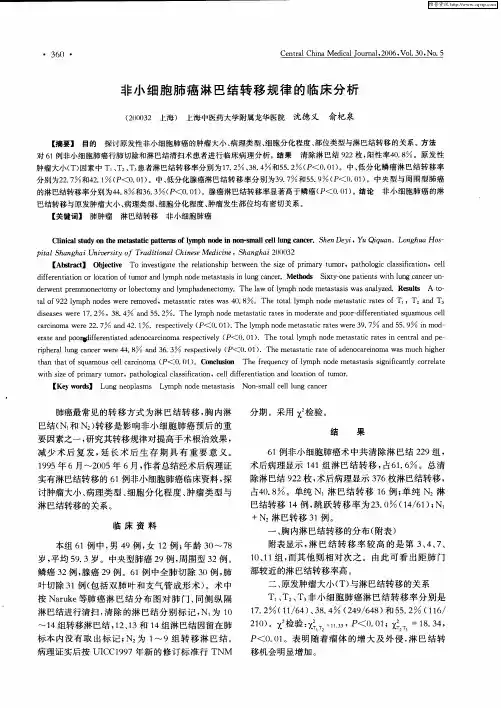
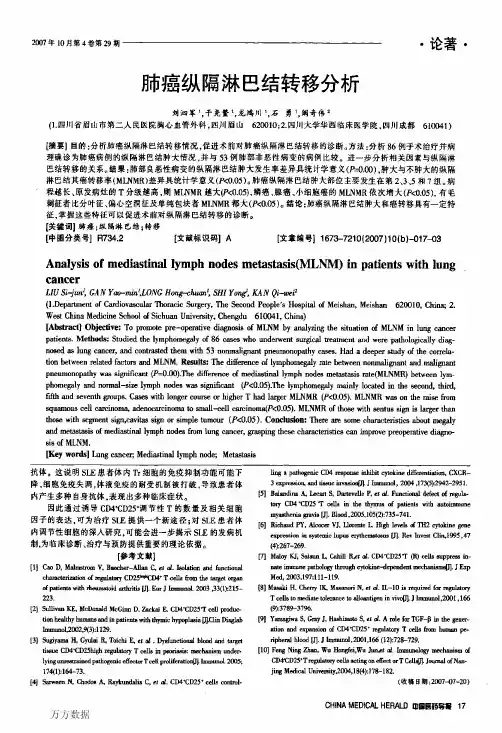
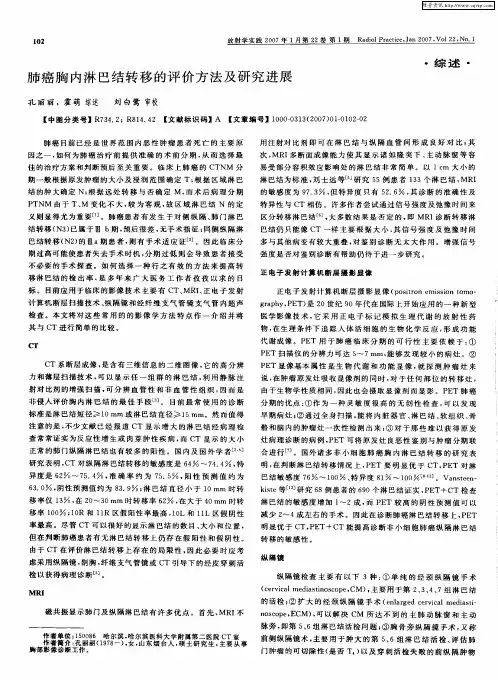
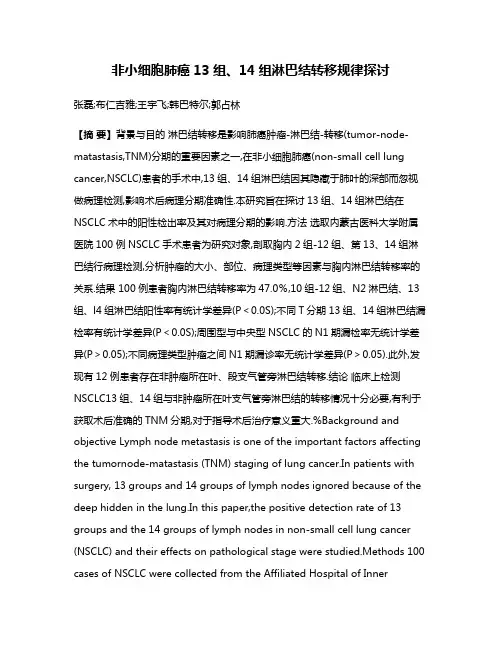
非小细胞肺癌13组、14组淋巴结转移规律探讨张磊;布仁吉雅;王宇飞;韩巴特尔;郭占林【摘要】背景与目的淋巴结转移是影响肺癌肿瘤-淋巴结-转移(tumor-node-matastasis,TNM)分期的重要因素之一,在非小细胞肺癌(non-small cell lung cancer,NSCLC)患者的手术中,13组、14组淋巴结因其隐藏于肺叶的深部而忽视做病理检测,影响术后病理分期准确性.本研究旨在探讨13组、14组淋巴结在NSCLC术中的阳性检出率及其对病理分期的影响.方法选取内蒙古医科大学附属医院100例NSCLC手术患者为研究对象,剖取胸内2组-12组、第13、14组淋巴结行病理检测,分析肿瘤的大小、部位、病理类型等因素与胸内淋巴结转移率的关系.结果 100例患者胸内淋巴结转移率为47.0%,10组-12组、N2淋巴结、13组、l4组淋巴结阳性率有统计学差异(P<0.0S);不同T分期13组、14组淋巴结漏检率有统计学差异(P<0.0S);周围型与中央型NSCLC的N1期漏检率无统计学差异(P>0.05);不同病理类型肿瘤之间N1期漏诊率无统计学差异(P>0.05).此外,发现有12例患者存在非肿瘤所在叶、段支气管旁淋巴结转移.结论临床上检测NSCLC13组、14组与非肿瘤所在叶支气管旁淋巴结的转移情况十分必要,有利于获取术后准确的TNM分期,对于指导术后治疗意义重大.%Background and objective Lymph node metastasis is one of the important factors affecting the tumornode-matastasis (TNM) staging of lung cancer.In patients with surgery, 13 groups and 14 groups of lymph nodes ignored because of the deep hidden in the lung.In this paper,the positive detection rate of 13 groups and the 14 groups of lymph nodes in non-small cell lung cancer (NSCLC) and their effects on pathological stage were studied.Methods 100 cases of NSCLC were collected from the Affiliated Hospital of InnerMongolia Medical University as the research object,cut out the intrathoracic 2-12 group,13,14 lymph node metastasis rate for pathological examination,relationship factors of statistical analysis of the size of primary tumor,location,pathological type and lymph node.Results 100 cases of patients with intrathoracic lymph node metastasis rate was 47.0%,with the 10-12 groups lymph node,N2 lymph nodes,13,14 groups lymph node positive rate had significant differences (P<0.05);T stage 13,14 groups of lymph node detection rate has statistically significant difference (P<0.05);peripheral and central NSCLC stage N1 undetected rate no statistical difference (P>0.05);various pathological types of tumors between N1 missed rate had no significant difference (P>0.05).In addition,12 patients were found to have non-tumor-derived lobe lymph nodemetastasis.Conclusion It is necessary to detect the metastatic lymph nodes of 13,14 group and non-tumor-derived lobe in NSCLC.It is helpful to obtain accurate TNM staging and to guide postoperative treatment.【期刊名称】《中国肺癌杂志》【年(卷),期】2017(020)004【总页数】5页(P248-252)【关键词】肺肿瘤;淋巴结;转移【作者】张磊;布仁吉雅;王宇飞;韩巴特尔;郭占林【作者单位】010050呼和浩特,内蒙古医科大学附属医院胸外科;010050呼和浩特,内蒙古医科大学附属医院胸外科;010050呼和浩特,内蒙古医科大学附属医院胸外科;010050呼和浩特,内蒙古医科大学附属医院胸外科;010050呼和浩特,内蒙古医科大学附属医院胸外科【正文语种】中文肺癌是我国发病率和死亡率最高的恶性肿瘤[1],非小细胞肺癌(non-small cell lung cancer, NSCLC)是肺癌的主要类型,治疗方法是以手术为主的综合治疗,其术后5年生存率仅为24.4%[2]。
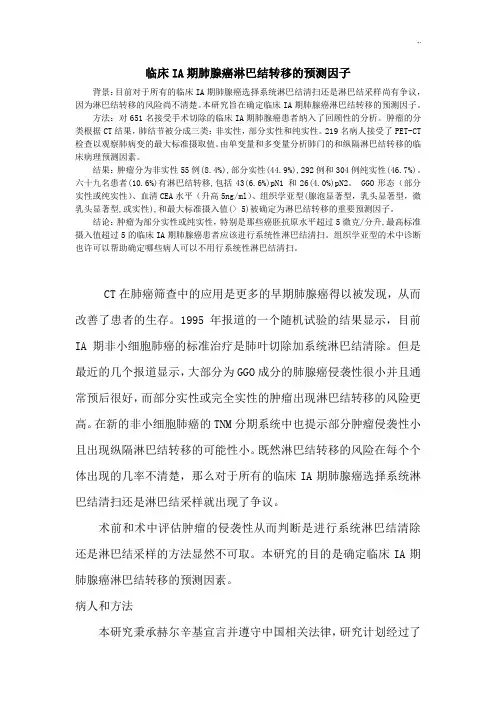
临床IA期肺腺癌淋巴结转移的预测因子背景:目前对于所有的临床IA期肺腺癌选择系统淋巴结清扫还是淋巴结采样尚有争议,因为淋巴结转移的风险尚不清楚。
本研究旨在确定临床IA期肺腺癌淋巴结转移的预测因子。
方法:对651名接受手术切除的临床IA期肺腺癌患者纳入了回顾性的分析。
肿瘤的分类根据CT结果,肺结节被分成三类:非实性,部分实性和纯实性。
219名病人接受了PET-CT 检查以观察肺病变的最大标准摄取值。
由单变量和多变量分析肺门的和纵隔淋巴结转移的临床病理预测因素。
结果:肿瘤分为非实性55例(8.4%),部分实性(44.9%),292例和304例纯实性(46.7%)。
六十九名患者(10.6%)有淋巴结转移,包括43(6.6%)pN1 和26(4.0%)pN2。
GGO形态(部分实性或纯实性)、血清CEA水平(升高5ng/ml)、组织学亚型(腺泡显著型,乳头显著型,微乳头显著型,或实性),和最大标准摄入值(> 5)被确定为淋巴结转移的重要预测因子。
结论:肿瘤为部分实性或纯实性,特别是那些癌胚抗原水平超过5微克/分升,最高标准摄入值超过5的临床IA期肺腺癌患者应该进行系统性淋巴结清扫。
组织学亚型的术中诊断也许可以帮助确定哪些病人可以不用行系统性淋巴结清扫。
CT在肺癌筛查中的应用是更多的早期肺腺癌得以被发现,从而改善了患者的生存。
1995年报道的一个随机试验的结果显示,目前IA期非小细胞肺癌的标准治疗是肺叶切除加系统淋巴结清除。
但是最近的几个报道显示,大部分为GGO成分的肺腺癌侵袭性很小并且通常预后很好,而部分实性或完全实性的肿瘤出现淋巴结转移的风险更高。
在新的非小细胞肺癌的TNM分期系统中也提示部分肿瘤侵袭性小且出现纵隔淋巴结转移的可能性小。
既然淋巴结转移的风险在每个个体出现的几率不清楚,那么对于所有的临床IA期肺腺癌选择系统淋巴结清扫还是淋巴结采样就出现了争议。
术前和术中评估肿瘤的侵袭性从而判断是进行系统淋巴结清除还是淋巴结采样的方法显然不可取。
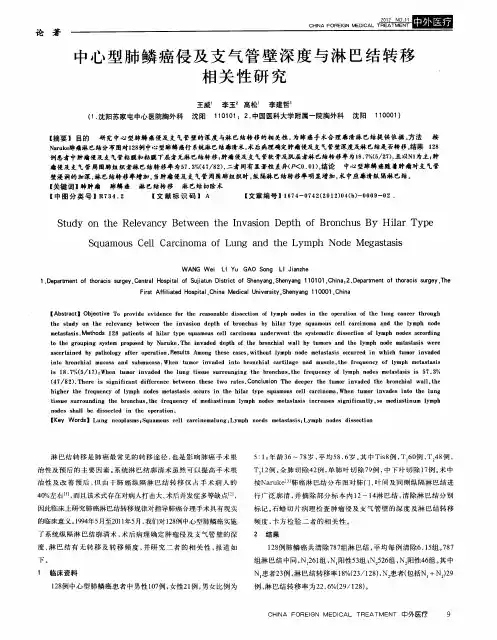
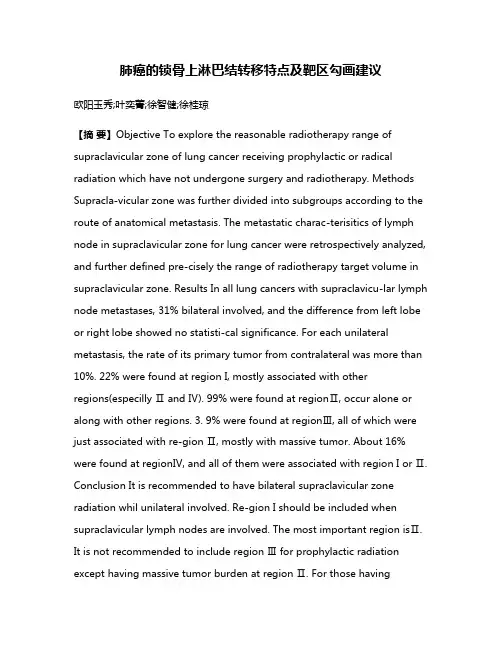
肺癌的锁骨上淋巴结转移特点及靶区勾画建议欧阳玉秀;叶奕菁;徐智健;徐桂琼【摘要】Objective To explore the reasonable radiotherapy range of supraclavicular zone of lung cancer receiving prophylactic or radical radiation which have not undergone surgery and radiotherapy. Methods Supracla-vicular zone was further divided into subgroups according to the route of anatomical metastasis. The metastatic charac-terisitics of lymph node in supraclavicular zone for lung cancer were retrospectively analyzed, and further defined pre-cisely the range of radiotherapy target volume in supraclavicular zone. Results In all lung cancers with supraclavicu-lar lymph node metastases, 31% bilateral involved, and the difference from left lobe or right lobe showed no statisti-cal significance. For each unilateral metastasis, the rate of its primary tumor from contralateral was more than 10%. 22% were found at region I, mostly associated with otherregions(especilly Ⅱ and Ⅳ). 99% were found at regionⅡ, occur alone or along with other regions. 3. 9% were fo und at regionⅢ, all of which were just associated with re-gion Ⅱ, mostly with massive tumor. About 16% were found at regionⅣ, and all of them were associated with region I or Ⅱ. Conclusion It is recommended to have bilateral supraclavicular zone radiation whil unilateral involved. Re-gion I should be included when supraclavicular lymph nodes are involved. The most important region isⅡ. It is not recommended to include region Ⅲ for prophylactic radiation except having massive tumor burden at region Ⅱ. For th ose havingmassive tumor burden at region Ⅰ or Ⅱ, it should consider to expand to region Ⅳ.%目的探寻未手术及放疗的肺癌行根治性或预防性放疗锁骨上淋巴结靶区勾画的范围.方法将锁骨上区域按主要解剖转移途径分区,回顾分析肺癌在锁骨上淋巴结的转移分布特点,进一步精确肺癌在锁骨上淋巴结靶区勾画范围.结果在所有有锁骨上淋巴结转移的肺癌病例中有双侧锁骨上淋巴结的占31%.锁骨上淋巴结Ⅰ区出现的占22%,多数以与其他区(如Ⅱ区及Ⅳ区)同时出现.锁骨上Ⅱ区淋巴结占绝大部分,99%,与他区一同出现或单独出现.锁骨上Ⅲ区出现淋巴结约3.9%,且全部合并有Ⅱ区淋巴结转移,多伴有大的肿瘤负荷,纵隔及锁骨上广泛的淋巴结转移.Ⅳ区出现淋巴结占16%,均合并有Ⅰ区或Ⅱ区淋巴结.结论推荐出现一侧锁骨上淋巴结转移者行双侧锁骨上淋巴结区预防照射;Ⅰ区需包括;重点勾画Ⅱ区锁骨上淋巴结区;不推荐在锁骨上淋巴结区域预防性勾画时包Ⅲ区,但在Ⅱ区淋巴结肿瘤负荷较大时可个体化适当包;推荐在Ⅰ区或Ⅱ区较大肿瘤负荷时考虑扩展Ⅱ区范围至Ⅳ区.【期刊名称】《临床肺科杂志》【年(卷),期】2016(021)004【总页数】3页(P643-645)【关键词】肺癌;锁骨上淋巴结;放射治疗;临床靶区【作者】欧阳玉秀;叶奕菁;徐智健;徐桂琼【作者单位】528403 广东中山,中山市人民医院;528403 广东中山,中山市人民医院;528403 广东中山,中山市人民医院;528403 广东中山,中山市人民医院【正文语种】中文在局部晚期非小细胞肺癌中,受累野照射比选择性淋巴结照射改善了生存[1,2],NCCN推荐行受累野照射[3-5]。


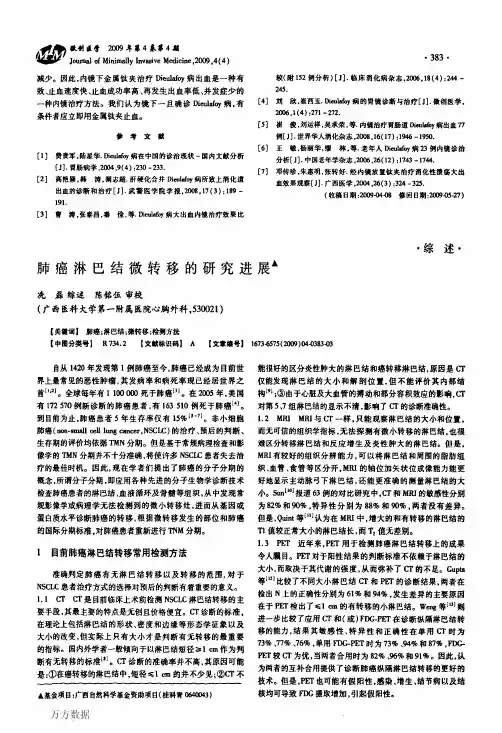
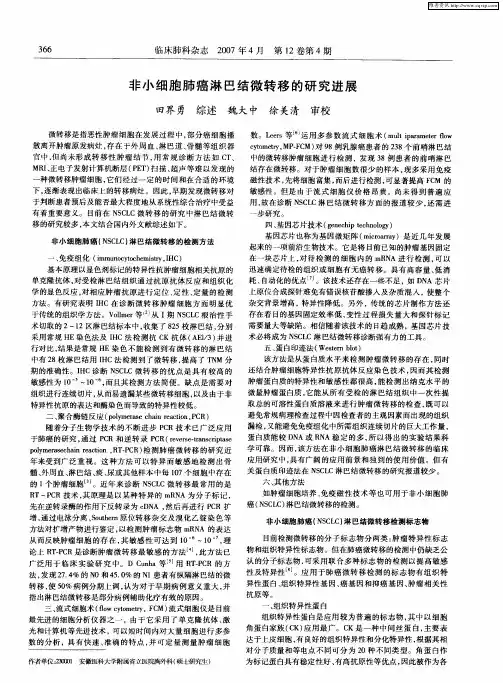
肺癌转移途径肺癌的生长速度以及扩散和转移情况,决定于癌细胞的组织学类型和分化程度以及病人的免疫功能状态。
一般有下列数种途径。
(一)局部直接蔓延扩散癌肿在支气管壁发生后可向支气管腔内生长,引致管腔狭窄或完全阻塞。
癌肿向支气管外长大即侵入肺组织,再蔓延扩展侵及邻近的器官组织。
中央型肺癌蔓延扩展入肺门、纵隔后即可压迫或侵犯淋巴、血管,神经以及位于纵隔的多种器官和组织。
靠近肺边缘部位的周围型肺癌则常侵及胸膜,引起胸膜腔积液和胸壁转移。
癌肿尚可穿越肺叶间裂侵入相邻的其它肺叶。
巨大的癌肿由于中心部分缺血、组织坏死、液化,形成癌性空洞。
(二)淋巴道转移淋巴道转移是支气管肺癌常见的主要扩散途径。
未分化小细胞癌在较早阶段即可经淋巴道转移,鳞状上皮细胞癌经淋巴道转移甚为多见。
腺癌常经血道转移,但亦可发生淋巴道转移。
癌细胞经支气管和肺血管周围的淋巴管道先侵入邻近的肺段或肺叶,支气管旁淋巴结,然后根据肺癌所在部位到达肺门、气管隆突下、纵隔、气管旁淋巴结,再累及锁骨上、前斜角肌和颈部淋巴结。
纵隔气管旁和颈部淋巴结转移,一般发生在肺癌的同侧,左侧肺癌淋巴转移可发生在肺癌的对侧,即所谓交叉转移。
肺癌侵入胸壁和膈面胸膜后,可经淋巴道转移到腋下、颈部和上腹部淋巴结。
(三)血道转移肺癌发生血道转移者病变已进入晚期。
未分化癌可较早呈现血道转移。
腺癌经血道转移较为多见。
晚期鳞状上皮细胞癌经血道转移亦不少见。
通常癌细胞侵入肺静脉系统,然后经左心随体循环血流而转移到全身各处器官和组织,最常见的转移部位有肝、骨骼、肾上腺、肾、脑等。
(四)气道播散少数肺癌病例脱落的癌细胞可经气管扩散植入同侧或对侧其他肺段或肺叶,形成新的癌灶。
细支气管肺泡癌较常发生气道播散。
在人类与肺癌抗争中,医药学专家潜心研究,在治疗方法和药物研究方面取得了长足的进展。
人参皂苷Rh2就是近年来一个重要的抗肿瘤研究成果,其高效无毒的特点弥补了以往一些药物和治疗方法的不足,必将在抗肿瘤领域发挥其重要的作用。
肺癌转移的途径 一、淋巴转移:淋巴转移是常见的扩散途径。
癌细胞经支气管和肺血管周围的淋巴管,先侵入邻近的肺段或肺叶支气管周围的淋巴结,然后根据肺癌所在部位,到达肺门或气管隆凸下淋巴结,再侵入纵隔和气管旁淋巴结,最后累及锁骨上前斜角肌淋巴结。
纵隔和气管旁以及颈部淋巴结转移一般发生在同侧,也可以在对侧,即所谓交叉转移。
也可向腋下、或上腹部主动脉旁淋巴结转移。
二、局部直接蔓延:癌组织沿支气管及肺泡孔向同侧附近或对侧肺直接蔓延,以肺泡细胞癌多见。
也可向四周,如纵隔、心包、横膈、胸膜和肺侵犯,时常由近向远处扩散,以肺鳞癌、腺癌多见。
三、血行转移:血行转移是肺癌的晚期表现。
小细胞癌和腺癌的血行转移较鳞癌更常见。
通常癌细胞直接侵入肺静脉,然后经左心随大循环血流而转移到全身各处器官,常见的有肝、骨骼、脑、肾上腺等。
也可通过血行发生肺内转移。
四、局部种植:常见于手术切口处或胸腔穿刺针孔处。
肺癌转移的防治 肺部由于淋巴组织分布广泛,血流运行丰富,因此肺癌病人更容易在早期就发生远处病灶转移,甚至有很多病人是由于发现了与远处转移有关的症状,才去就医并确诊为肺癌的,这的确给治疗带来了非常大的困难。
而不少经过了详细检查,被确认尚未发生远处转移的肺癌患者,可能在手术切除原发病灶几个月或一两年后,会发生远处转移。
其实这些转移病灶早已存在,只是手术之前很小,经过一段时间,它们渐渐长大,才能被影像学或临床检查发现。
“星星之火,可以燎原”,即使是原来非常微小的转移灶,随着癌细胞继续增殖,病灶日益发展,同样可致人死命。
针对这部分病人,应考虑手术切除肺癌病灶后,再给予全身的综合疗,以求早期控制。
由于肺癌的转移速度非常迅速,因此那些早期首先发现有肺部原发病灶的患者,在被确诊为肺癌之后,就必须立即做骨扫描、脑CT或磁共振检查是否有远处病灶的转移。
就算没有,也不能麻痹大意,应该听从医生的建议根据个人的情况随时到门诊进行复查,以期将远处病灶转移的可能降到最低。